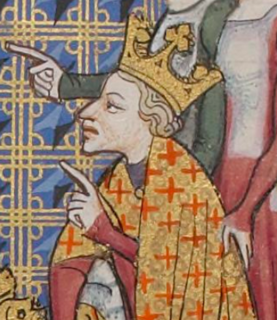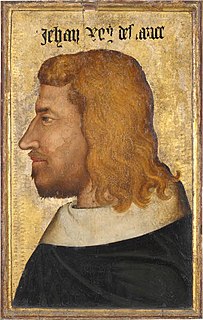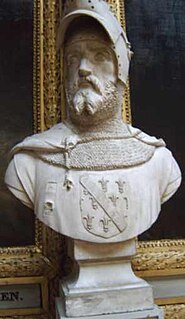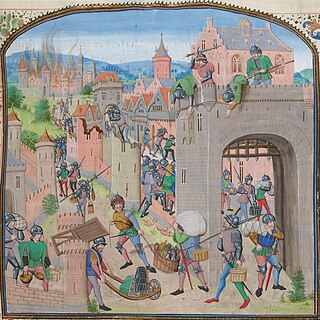


Seguin de Badefol was a Medieval leader of a large bandit army or Routier [1] [2] [3] With 2000 troops he was the head of the largest group of Tard-Venus.



Seguin de Badefol was a Medieval leader of a large bandit army or Routier [1] [2] [3] With 2000 troops he was the head of the largest group of Tard-Venus.
He was born in 1330 in the castle of Badefols, the son of Seguin Gontaut de Badefol and Margaret de Bérail, daughter of Arnaud de Cervole he was given the nickname Chopin Badefol.
He fought at the Battle of Poitiers in 1356 and in 1360 after the Treaty of Brétigny, and without employ, he led a band of brigands, with Bertucat d'Albret in 1361 into the Languedoc, Roussillon, Toulouse and Rouergue districts. In 1362, with Bertucat took Montbrun, plundered Saint-Flour then participated with Meschin, at the Battle of Brignais against Jacques de Bourbon Count of La Marche. In 1363, refusing to go to Italy with most of the other Routiers, he returned to plunder the Languedoc area with Petit Meschin, Louis Rabaud, Arnaud du Solis and Espiote took Brioude on 13 September.
In 1364, the band devastated the region between Lyon and Mâcon. When Seguin Brioude evacuated Clermont under an agreement of 21 May 1364, he did not immediately withdraw in Gascony. Instead he stayed at and became master of the Saone and Rhone region and captured sixty castles including that of Anse in November 1364. After eight months of occupation, in July 1365 Pope Urban V, gave John II of France a sum of 40,000 florins to pay his company out of the kingdom. To enforce this the pope held his father and brothers as hostages in Avignon. At the end of arguments the Pope paid the Tard-Venus to leave and then excommunicated Badefol around August 1365.
The troops of Seguin Badefol also made raids in Puy, Chaise-Dieu in Clermont, Montferrand, Chilhac, Riom, Nonnette, Issoire, Saint-Bonnet Arsis and ravaging Auvergne. Finally, after holding Brioude for more than a year, Seguin Badefol evacuates for a fee and retires with his treasures to Gascony, his native country.
Here Charles II of Navarre employed him but while in his service he was poisoned with figs in Pamplona in December 1365. The historian Germain Butaud, believes he died of poison in Falces in February 1366 after eating quince and pears. [4]

Pope Urban V, born Guillaume de Grimoard, was the head of the Catholic Church from 28 September 1362 until his death in 1370 and was also a member of the Order of Saint Benedict. He was the only Avignon pope to be beatified.

Charles II, called Charles the Bad, was King of Navarre 1349–1387 and Count of Évreux 1343–1387.

Charles V, called the Wise, was King of France from 1364 to his death in 1380. His reign marked an early high point for France during the Hundred Years' War, with his armies recovering much of the territory held by the English, and successfully reversed the military losses of his predecessors.

John II, called John the Good, was King of France from 1350 until his death in 1364. When he came to power, France faced several disasters: the Black Death, which killed nearly 40% of its population; popular revolts known as Jacqueries; free companies of routiers who plundered the country; and English aggression that resulted in catastrophic military losses, including the Battle of Poitiers of 1356, in which John was captured.

Auvergne is a former administrative region in central France, comprising the four departments of Allier, Puy-de-Dôme, Cantal and Haute-Loire. Since 1 January 2016, it has been part of the new region Auvergne-Rhône-Alpes.

James I of Bourbon, was a French prince du sang, and the son of Louis I, Duke of Bourbon and Mary of Avesnes. He was Count of Ponthieu from 1351 to 1360, and Count of La Marche from 1341 to his death.
Arnaud de Cervole, also de Cervolles, de Cervolle, Arnaut de Cervole or Arnold of Cervoles, known as l'Archiprêtre, was a French mercenary soldier and Brigand of the Hundred Years War in the 14th century.

Rodrigo de Villandrando was a Spanish routier from Castile and mercenary military leader in Gascony during the final phase of the Hundred Years' War. He was famous for his pillaging and was consequently known as the Emperor of Pillagers or L'Écorcheur.

A free company was an army of mercenaries between the 12th and 14th centuries recruited by private employers during wars. They acted independently of any government, and were thus "free". They regularly made a living by plunder when they were not employed; in France they were called routiers and écorcheurs and operated outside the highly structured law of arms. The term "free company" is most often applied to those companies of soldiers which formed after the Peace of Brétigny during the Hundred Years' War and were active mainly in France, but it has been applied to other companies, such as the Catalan Company and companies that operated elsewhere, such as in Italy and the Holy Roman Empire.

The Massacre at Béziers occurred on 22 July 1209 during the sack of Béziers by crusaders. It was the first major military action of the Albigensian Crusade.

The Château de Bélarga is a château constructed in the 17th century. Part of the building is from an earlier castle dating from the 14th and 15th centuries. It is located on the left bank of the Hérault River in the commune of Bélarga in the Hérault département of France.
Tard-Venus were medieval groups of routiers that ravaged Europe in the later years of the reign of King John II of France.

Bascot de Mauléon was a Basque soldier, mercenary and Brigand of the Hundred Years' War in the 14th century.

Le Petit Meschin was a French soldier, mercenary and brigand of the Hundred Years War in the 14th century.

Francois Hennequin, was a mercenary captain during the Hundred Years War.

Aymon of Ortinge, also known as Amanieu d'Ortigue or Amanieu de l'Artigue, was a French mercenary captain during the Hundred Years War. His story is mentioned in the Chronicles of Froissart

Bernard de la Salle, was a French mercenary captain during the Hundred Years War. His story is mentioned in the Chronicles of Froissart

Bertucat d'Albret was a medieval mercenary leader of a bandit army in the Hundred Years' War.
Viking incursions into Gascony began with a first raid in 840 and ended in 982 with the battle of Taller.